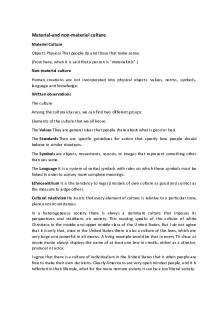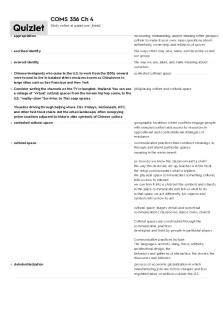Chapter 8 Non Verbal Communication and Culture PDF

| Title | Chapter 8 Non Verbal Communication and Culture |
|---|---|
| Author | Martin Mirek |
| Course | Issues in Intercultural Communication |
| Institution | Brock University |
| Pages | 5 |
| File Size | 83.2 KB |
| File Type | |
| Total Downloads | 51 |
| Total Views | 154 |
Summary
Download Chapter 8 Non Verbal Communication and Culture PDF
Description
8 NONVERBAL COMMUNICATION AND CULTURE LEARNING OBJECTIVES After this chapter, you should be able to: • Define nonverbal communication. • Identify characteristics and functions of nonverbal communication. • Evaluate different types of nonverbal code. • Explain the influence of culture on nonverbal communication. Body movement (kinesics) Vocal qualities (paralanguage) The use of time (chronemics) Space (Proxemics) Artefacts, dress, and smell (olfactics) Characteristics of nonverbal codes Pg 330 verbal and nonverbal are? Pg 331 Verbal behavior to convey the? Nonverbal component of the message? While we normally have control over the words we say, we? Three ways in which verbal and nonverbal codes differ? First, Language system is based primarily on Second way in which the nonverbal system differs from its? Hard to communicate nonverbally without A third difference is that verbal codes have Pg 332 The meanings of nonverbal behavior are also usually? Nonverbal behavior is not learned but Functions of nonverbal codes Pg 335 Six primary functions of nonverbal communication?
Repeat a verbal message use nonverbal codes to? Verbal and nonverbal communication is usually largely Contradict a verbal message When verbal and nonverbal codes contradict, people tend to Pg 336 Substitute for a verbal message For a verbal message in noisy places or in a situation when a common language… Some messages that are difficult to express in words can be Complement a verbal message Nonverbal message can Pg 337 For example, a man involved in a car accident may be able to.. Accentuate a verbal message The former ( accentuating) specifically increases or decreases the what? A manager may pound his ___ firmly on the table to emphasize his feelings A colleague may use a neutral tone of voice to ___ the intensity of negative words Nonverbal codes accent the emotions conveyed by Regulate verbal communication Use nonverbal codes to tell others to do or not to do something We use voice inflection, head nods, and hand movements Types of nonverbal communication Kinesics: body movement Gesture,hand and arm movements, leg movements, facial expressions, eye contact, and posture Five broad categories emblems, illustrators affect displays, regulators, and adaptors
Emblems: direct literal verbal translation Blur verbal and nonverbal communication Illustrators are hand and arm movements that function to complement or accent words Metacommunicative function Example: describe size of a crocodile using hand gestures Affect displays: facial expressions that communicate an emotional state Linked to cultural context Regulators: behaiours and actions that overn or manage conversation Head nodding and silence to show interest Adaptors: to satisfy physiological or psychological needs Scratching an itch Interpretation of any kinesic behavior depends on its context and the other communication that takes place at the same time
Proxemics: the use of space Use of space, including territory, which stands for the space that an individual claims permanently or temporarily The size of ones office, a fixed feature of space, communicates status and power Chronemics: the use of time Concept of time influences our communication behavior Different conceptions of time lead people to attempt only one task at a time or to multi task Monochromic and polychromic Monochromic: linear Discrete compartments Time can be bought saved spent wasted lost or made up Polychromic view time as cyclical
Perform multiple tasks simultaneously Use of calendar Gregorian calendar universally Haptics: the use of touch Protection support approval or encouragement Amount of touch varies with age, sex,situation, and the relationship North American and Mediterranean High and low contact cultures Western cultures, consider homosexual Physical appearance and dresss Wear a particular type of clothes to communicate culture, religion, status, power, personality, self esteem, and social identity Frith and colleagues found western women appear in clothing ads Asian model/facial and beauty products Body and face vs face White beauty ideal Paralanguage:quality and characteristics of the voice Vocal qualities that accompany speech Voice qualities and vocalizations Pitch volume tempo, etc Laughing crying,etc Verbal and nonverbal blurred Olfactis the use of smell,scent, and odour Communicate position social class and pwer Influence of culture on nonverbal communication Three cultural variation in nonverbal communication
1. Cultures differ in their specific repertoire of behavior Body movements, gestures, posture, vocal qualities, and spatial requirement specific to culture 2. all cultural have display rules which govern when and in what context certain nonverbal expression are required permitted, preferred or prohibited 3. meaning attributed to particular nonverbal behavior differs from culture to culture Learning nonverbal only occurs through the process of socialization, no grammar rules Outside conscious awareness Summary • Unlike verbal codes, there is no formal grammar governing the use of nonverbal codes. These rules are learned as part of a culture’s socialization process. • Nonverbal communication often takes place simultaneously with verbal communication; however, if the messages from the two contradict one another, people tend to believe the nonverbal communication because it is believed to be less controlled and thus more likely to reveal the true feelings of the speaker. • Nonverbal codes are used to: repeat the message sent by the verbal code; contradict the verbal message; substitute a verbal message; complement a verbal message; accentuate the verbal; and regulate verbal communication. • There are seven major types of nonverbal code system: kinesics, proxemics, chronemics, haptics, physical appearance and dress, paralanguage, and olfactics,...
Similar Free PDFs

NON Verbal Communication
- 3 Pages

NON- Verbal Communication
- 4 Pages

Chapter 8 Culture and Communication
- 20 Pages

Komunikasi Verbal dan Non-Verbal
- 36 Pages

10. Non Verbal Reasoning
- 10 Pages
Popular Institutions
- Tinajero National High School - Annex
- Politeknik Caltex Riau
- Yokohama City University
- SGT University
- University of Al-Qadisiyah
- Divine Word College of Vigan
- Techniek College Rotterdam
- Universidade de Santiago
- Universiti Teknologi MARA Cawangan Johor Kampus Pasir Gudang
- Poltekkes Kemenkes Yogyakarta
- Baguio City National High School
- Colegio san marcos
- preparatoria uno
- Centro de Bachillerato Tecnológico Industrial y de Servicios No. 107
- Dalian Maritime University
- Quang Trung Secondary School
- Colegio Tecnológico en Informática
- Corporación Regional de Educación Superior
- Grupo CEDVA
- Dar Al Uloom University
- Centro de Estudios Preuniversitarios de la Universidad Nacional de Ingeniería
- 上智大学
- Aakash International School, Nuna Majara
- San Felipe Neri Catholic School
- Kang Chiao International School - New Taipei City
- Misamis Occidental National High School
- Institución Educativa Escuela Normal Juan Ladrilleros
- Kolehiyo ng Pantukan
- Batanes State College
- Instituto Continental
- Sekolah Menengah Kejuruan Kesehatan Kaltara (Tarakan)
- Colegio de La Inmaculada Concepcion - Cebu










